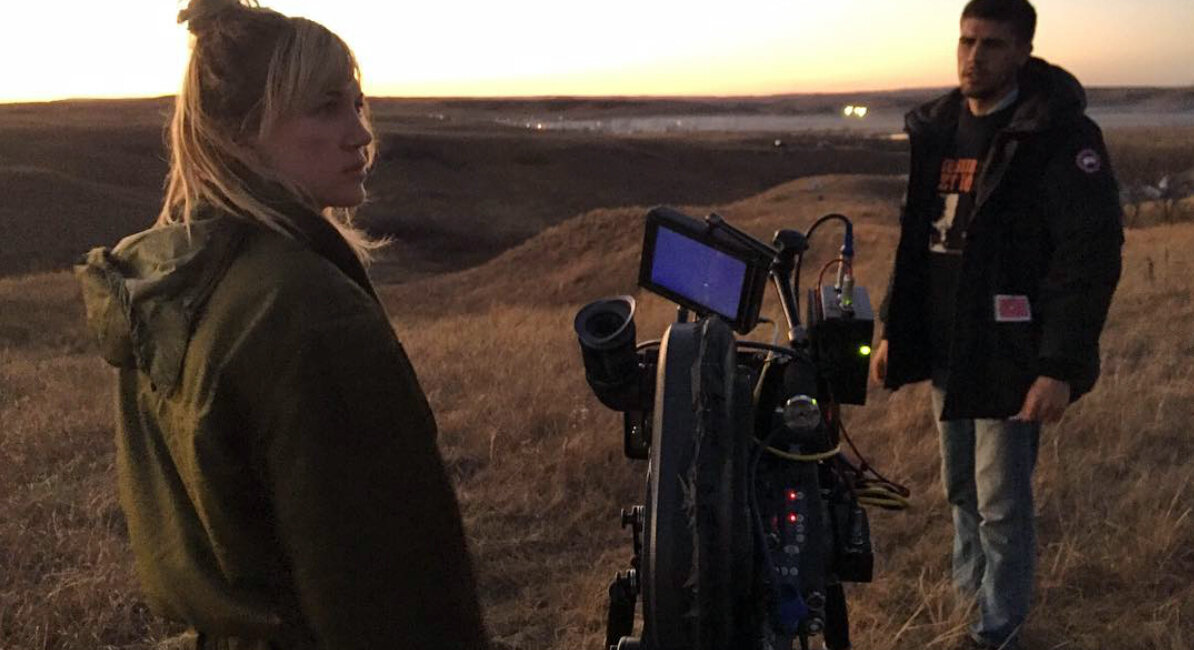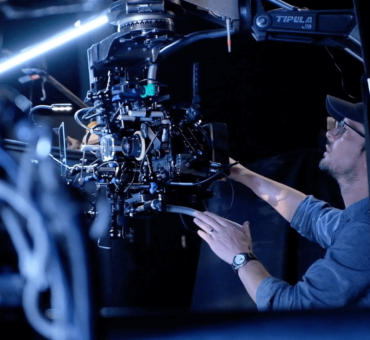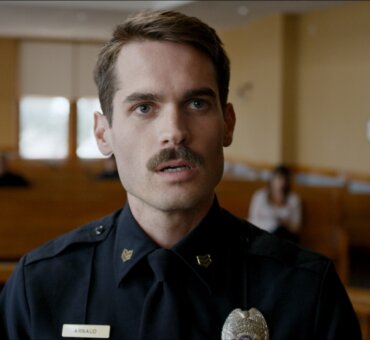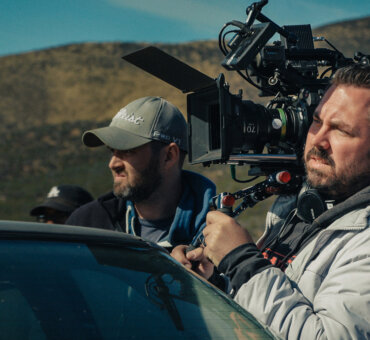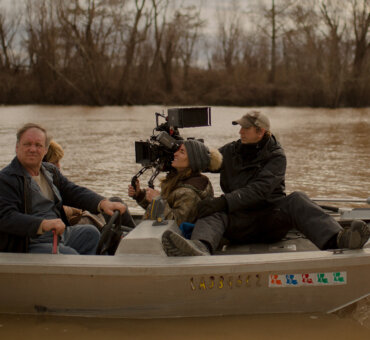Werner Herzog says that risk is the lifeblood of cinema. If that’s true, then Bennett Johnson’s documentary music video for Foreign Field’s “Hope Inside the Fire” is one of the most alive films we’ve seen all year. Not only was it shot in the middle of the Dakota Access Pipeline protests on expired film stock with no script or plan whatsoever, but the form itself was breaking new ground. “It was the documentary music video thing that scared me the most,” Bennett told us. “Most people hadn’t ever seen that before so I really didn’t know if it was going to work. … Some people were definitely like, ‘You should have just shot a documentary.’ ”
We couldn’t disagree with those people more. “Hope Inside the Fire” is an intensely emotive glimpse inside one of the most outrageous human rights violations of our time. It doesn’t attempt to “cover” or “explain” the events (plenty of other amazing and important documentaries have done that); rather, it gets inside of them. “I’m interested in being on the inside, being inside your characters, and looking out,” Bennett says. “It’s almost like emotional VR.”
We spoke to Bennett about his Cannes Lions – Gold film, “Hope Inside the Fire.” It was July 11.
Musicbed: We don’t know if you know this being from England and all, but today 7-Eleven gives people free slurpees.
Bennett Johnson: What? Get out of town.
It’s true.
That could very easily be abused.
It is.
You’d think they’d go bankrupt.
It’s the most generous act in corporate history.
Yeah. Wow.
Which is maybe a good transition into “Hope Inside the Fire,” which is about a terrible act in corporate history. How did this music video happen?
I’d done a video for Foreign Fields previously, and they’d asked if I had any thoughts on another one of their tracks. At the time I was closely watching what was happening with the Dakota Access Pipeline and thinking about shooting a documentary there, but I didn’t know what angle I could bring to it. Then I started thinking about doing a music video there, which seemed risky, but also seemed to line up with the part of the story I was gravitating toward: the prayerful side. A lot of the footage coming out of the camps was of the intense protests and police brutality, which was a hugely important part of the story, but what I was really moved by was the fact that this was actually an incredibly peaceful and prayerful camp. The idea that when the stakes are this high, you have to look up and pray to a God you might not even believe in. I thought the poetry of that might fit with the format of a music video — plus, Foreign Fields’ track made so much sense for the subject and tone. The risky part is that music videos are often such a self-serving, vapid form. So we decided not to put the band’s name on it. Not put “directed by” on it. And to just see if we could bring something new to this story.
It can be scary attaching yourself to a cause. You see so many missteps. Pepsi and Black Lives Matter, for example.
The problem there was that they were just stealing a look and aesthetic but weren’t actually standing for anything. They were just saying “protesting is cool.” But protesting isn’t cool. People protest because their civil liberties or land aren’t being respected. There’s nothing cool about it. Pepsi wasn’t actually saying anything with their ad. But I think people respect when brands get behind a cause and take a stand. Risk something. You can’t just attach yourself to the aesthetic. You have to attach yourself to what is actually going on. The best art shouldn’t serve the artist or the brand; it should serve the subject or the story or the people. With this piece, we were there to be part of what was going on. We didn’t just roll into camp and start shooting. I was actually there for a full week before we even took out a camera. I hope that our really being there and being present translates into the film.[nectar_single_testimonial testimonial_style=”bold” color=”Default” quote=”The best art shouldn’t serve the artist or the brand; it should serve the subject or the story or the people.”]
That’s part of what’s so emotional about it. There’s definitely an intimacy with the subjects.
You can’t fake human connections. You can’t just put a lens on someone’s face. You have to really be with them, be present and listening. Without that, you’re telling the story from the outside looking in. You can get some cool imagery that way, but you’re still on the outside. I’m interested in being on the inside, being inside your characters, and looking out. It’s almost like emotional VR. I believe the ultimate power of film is empathy. And especially with a story like this, it was hard to empathize with some of the ways the story was being presented. But it’s very easy to empathize with the idea of your land being destroyed by an oil company. That’s a simple story. That could be you. Or me. Or anyone.
There’s very little exposition or education that happens in “Hope Inside the Fire.” You jump straight into the emotional heart of it.
That was a tricky decision, for sure. We played a lot with how much to explain up front. But to an extent we assumed that our audience knew a bit about what was going on. There were other documentaries showing the whole history of the story—the political crisis and the personal crisis. But our idea was to focus on the spiritual crisis. It might seem like a strange comparison, but we thought a lot about Anne Frank’s diary. It’s an amazing book because you know what’s going to happen, and that makes very simple things incredibly loaded and powerful. Things like “Gretel didn’t come to school today.” In any other context that doesn’t mean anything. But in this context, it means everything. Her diary isn’t the story of World War II. It’s moving because you’re put into an individual’s perspective inside the event rather than just learning about the massive topic. I think we were trying to do something similar.
What was the most unexpected part of this project for you?
How hard it was production-wise. We had no cell service out there. No plans. I was there seven days getting to know people, and then for five days we drove around in a van trying to spot people who would let us film them. As you’d imagine, it was a very hostile shooting environment. There’d actually been an infiltrator into the camp who was gathering information for the DAPL workers, so everyone was on edge. And it was hard enough building bridges as a tall, skinny white guy with an English accent. People were, very understandably, on edge. After being shot at with rubber bullets, you don’t necessarily want to sit down and be interviewed. A lot of people didn’t want to talk with us, which was totally fine.
So your strategy was basically random? No shot list or script?
After being there for seven days, I was aware of some of the situations I wanted to capture, but a lot of it was made up on the fly.
How did your philosophy about being on the inside looking out affect your decision making?
A lot of it was instinctual and intuitive. I’m not sure I can totally explain it. Some of it makes more sense looking back, like our decision not to include drone footage or reporting footage. For some reason it just didn’t sync. And I think the reason was because the film wasn’t about these wide drone shots of the pipeline. This was about the people on the ground who have to live with it. Some of them had been there for three months. Drone shots just felt irrelevant.
What equipment did you bring?
We had an ARRI 235, which is a 2-perf 35mm film camera. It’s an amazing camera. Then I had my RØDE H4N that I was recording interviews with people on. We shot on a bunch of expired film. New film is good, but if you shoot it clean it basically looks the same as the Alexa. Even if you shoot it two stops under-exposed, it’s just so clean. But if you get expired stock, that’s when you get these slightly abstract colors that are amazing and give the piece that magical realism tone we were going for. We under-exposed two stops to really put some of the grain back in and push the colors. That was basically it. An easy rig.
Is expired film cheaper?
It is. It’s cheap. You can buy it off eBay. As long as it’s been in a freezer, it’s fine. I mean, occasionally it’s a little bit funky, but you don’t mind. It just looks cool.
Werner Herzog says that risk is the lifeblood of cinema. That sounds true of this project on multiple levels.
I think this was the riskiest shoot I’ve ever done. Not just in terms of where we were and what we were shooting on and the fact that we had no cell service or plan to speak of, but because we were trying to make this weird music video documentary hybrid about a very important subject. You kind of assume it’s going to work, but obviously at any point the whole thing could have just died. And actually, it was the documentary music video thing that scared me the most. Most people hadn’t ever seen that before, so I really didn’t know if it was going to work. I think that’s probably why Cannes gave it the nod, because it was definitely something different. Although some people were definitely like, “You should have just shot a documentary.”
There’s some quote that says all great works of art either dissolve a genre or invent one.
I totally agree with that. I think it’s very tempting to create something you’ve seen before, something you know you’re going to get a certain kind of reaction or affirmation from. It’s tried and tested. But I think as a director or a creator it’s so important to develop your own distinct voice. I’ve made a ton of stuff that’s real actual shit. But that’s because I was trying to be original. I’m proud to have done something on this project that was original and that hopefully serves the people it’s about and gives a true representation of their struggle. You have two options. You can either make something you know will get you Vimeo views and Instagram likes by copying something that’s already been done before, or you can make something that nobody else has ever made. It could be very good or very terrible. I think it’s always better to try for something no one else has done before.
You can license Bennett’s footage here.
